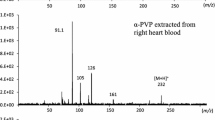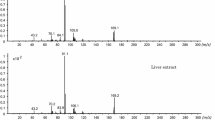Abstract
Toxicological analysis for chlorpromazine and diazepam was performed using chemically fixed organ tissue specimens. After chlorpromazine and diazepam had been injected into rabbits, organ tissues (brain, lung, liver, kidney and skeletal muscle) were collected and fixed in 3 fixative solutions: buffered 10% formalin solution (pH 7.4, 10% BF), non-buffered 10% formalin solution (pH 5.1, 10% non-BF), buffered 4% paraformaldehyde solution (pH 7.4, 4% BPA). Chlorpromazine and diazepam were determined by GC-MS (gas chromatography-mass spectrometry) after 5 different fixation periods, and were detected even after 28 days of fixation. Recoveries of chlorpromazine and diazepam in 10% BF were within the range 48–86% and 68–171%, respectively after 28-day fixation, those in 10% non-BF were 22–54% and 48–78%, respectively, and those in 4% BPA solution were 13–59% and 14–50%, respectively. Thus, 10% BF was found to be the most suitable fixation medium for analysis of chlorpromazine and diazepam.
Zusammenfassung
Chlorpromazin- und Diazepamgehalte aus fixiertem Organmaterial wurden bestimmt. Nach intravenöser Gabe von Chlorpromazin und Diazepam an neun Kaninchen, wurde Organmaterial (Gehirn, Lunge, Leber, Niere und Skelettmuskulatur) entnommen und nach drei unterschiedlichen Verfahren fixiert: 1. gepufferte (pH=7.4), 10%ige Formalin-Lsg., (10% BF); 2. ungepufferte (pH=5.1), 10%ige Formalin-Lsg., (10% nonBF) und 3. gepufferte (pH=7.4), 4%ige Paraformaldehyd-Lsg. (4% BPA). Nach 28 Tagen Fixierung wurden die Chlorpromazin- und Diazepamgehalte gaschromatographisch mit massenspezifischer Detektion (GC-MS) bestimmt. Die Wiederfindungsraten für Chlorpromazin und Diazepam lagen für die erste Variante (10% BF) zwischen 48–86% bzw. 68–171%, für die zweite Variante (10% non-BF) zwischen 22–54% bzw. 48–78% und für die dritte Fixierungsart (4% BPA) zwischen 13–59% bzw. 14–50%. Die Fixierung mit gepuffertem, 10%igem Formalin war die geeigneteste Fixierungsvariante zur anschlißenden Bestimmung von Chlorpromazin und Diazepam aus fixiertem Organmaterial.
Similar content being viewed by others
References
Tsoukali-Paradopoulou H (1987) Elucidation of a poisoning case from the analysis of formalin in which brain tissue was preserved. Forensic Sci Int 34: 63–65
Kuo T, Kuo C (1988) Determination of paraquat from formalin-fixed tissue. Forensic Sci Int 38: 243–249
Takayasu T, Ohshima T, Nishigami J, Kondo T, Lin Z, Ohtuji M, Nagano T (1994) Toxicological analysis for drugs and poisons using the formalin-fixed organ tissues -1. Methamphetamine. Jpn J Leg Med 48: 33–37
Investigation Committee of the Medico-Legal Society of Japan (1991) Reports on medico-legal data from the massive-investigation performed by the medico-legal society of Japan — A statistical study of death by poisoning. Jpn J Leg Med 45: 258–262
Winek CL (1985) Drug and chemical bloodlevel data 1985. Fisher Scientific Litho, USA
Baselt RC, Cravey RH (1989) Disposition of toxic drugs and chemicals in man. 3rd edn Chlorpromazine. Year book medical publishers, Chicago London Boca Raton Littleton, pp 177–182
Cardauns H, Iffland R (1973) Ober eine tödliche diazepam (Valium®) Vergiftung bei einem drogenabhängigen Jugendlichen. Arch Toxicol 31: 147–151
Dennis J (1972) Reactions of aldehydes with unsaturated fatty acids during histological fixation. Histochem J 4: 421–465
Yokogawa K, Nakashima E, Ishizaki J, Maeda H, Nagano T, Ichimura F (1990) Relationships in the structure-tissue distribution of basic drugs in the rabbit. Pharm Res 7: 691–696
Dealing RJ, Briglia EJ, Cortivo LAD, Bidanset JH (1990) The production of amitriptyline from nortriptyline in formaldehydecontaining solutions. J Anal Toxicol 14: 325–326
Winek CL, Zaveri NR, Wahba WW (1993) The study of tricyclic antidepressants in formalin-fixed human liver and formalin solutions. Forensic Sci Int 61: 175–183
Winek CL, Esposito FM, Cinicola DP (1990) The stability of several compounds in formalin-fixed tissues and formalinblood solutions. Forensic Sci Int 44: 159–168
Kudo K, Nagata T, Kimura K, Imamura T, Noda M (1988) Sensitive determination of diazepam and N-desmethyldiazepam in human material using capillary gas chromatographymass spectrometry. J Chromatogr 431: 353–359
Author information
Authors and Affiliations
Rights and permissions
About this article
Cite this article
Nishigami, J., Takayasu, T. & Ohshima, T. Toxicological analysis of the psychotropic drugs chlorpromazine and diazepam using chemically fixed organ tissues. Int J Leg Med 107, 165–170 (1995). https://doi.org/10.1007/BF01428398
Received:
Revised:
Issue Date:
DOI: https://doi.org/10.1007/BF01428398




